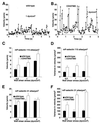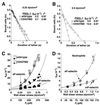Dimerization of a selectin and its ligand stabilizes cell rolling and enhances tether strength in shear flow
- PMID: 11481445
- PMCID: PMC56933
- DOI: 10.1073/pnas.171248098
Dimerization of a selectin and its ligand stabilizes cell rolling and enhances tether strength in shear flow
Abstract
Selectins mediate rolling of leukocytes by rapid formation and dissociation of selectin-ligand bonds, which are assumed to require high mechanical strength to prevent premature dissociation by the forces applied in shear flow. This assumption is based largely on the observation that increasing wall shear stress increases only modestly the dissociation of transient leukocyte tethers on very low selectin densities. P-selectin binds to the N-terminal region of P-selectin glycoprotein ligand-1 (PSGL-1), a mucin on leukocytes. Both PSGL-1 and P-selectin are extended homodimers. We perfused transfected cells expressing wild-type dimeric PSGL-1 or a chimeric monomeric form of PSGL-1 on immobilized dimeric or monomeric forms of P-selectin. Cells expressing dimeric or monomeric PSGL-1 tethered to P-selectin at equivalent rates. However, cells expressing dimeric PSGL-1 established more stable rolling adhesions, which were more shear resistant and exhibited less fluctuation in rolling velocities. On low densities of dimeric P-selectin, increasing wall shear stress more rapidly increased transient tether dissociation of cells expressing monomeric PSGL-1 than dimeric PSGL-1. Tether dissociation on low densities of monomeric P-selectin was even more shear sensitive. We conclude that dimerization of both PSGL-1 and P-selectin stabilizes tethering and rolling, probably by increasing rebinding within a bond cluster. Because transient tethers may have more than one bond, the mechanical strength of selectin-ligand bonds is likely to be lower than initially estimated. Tether strength may rely more on bond clusters to distribute applied force.
Figures





Comment in
-
Two by two: the pairings of P-selectin and P-selectin glycoprotein ligand 1.Proc Natl Acad Sci U S A. 2001 Aug 28;98(18):10023-4. doi: 10.1073/pnas.191367898. Proc Natl Acad Sci U S A. 2001. PMID: 11526223 Free PMC article. No abstract available.
References
-
- Vestweber D, Blanks J E. Physiol Rev. 1999;79:181–213. - PubMed
-
- McEver, R. P. (2001) Thromb. Haemostasis, in press.
-
- Lawrence M B, Springer T A. Cell. 1991;65:859–873. - PubMed
-
- Nicholson M W, Barclay A N, Singer M S, Rosen S D, Van der Merwe P A. J Biol Chem. 1998;273:763–770. - PubMed
-
- Mehta P, Cummings R D, McEver R P. J Biol Chem. 1998;273:32506–32513. - PubMed
Publication types
MeSH terms
Substances
Grants and funding
LinkOut - more resources
Full Text Sources
Other Literature Sources

